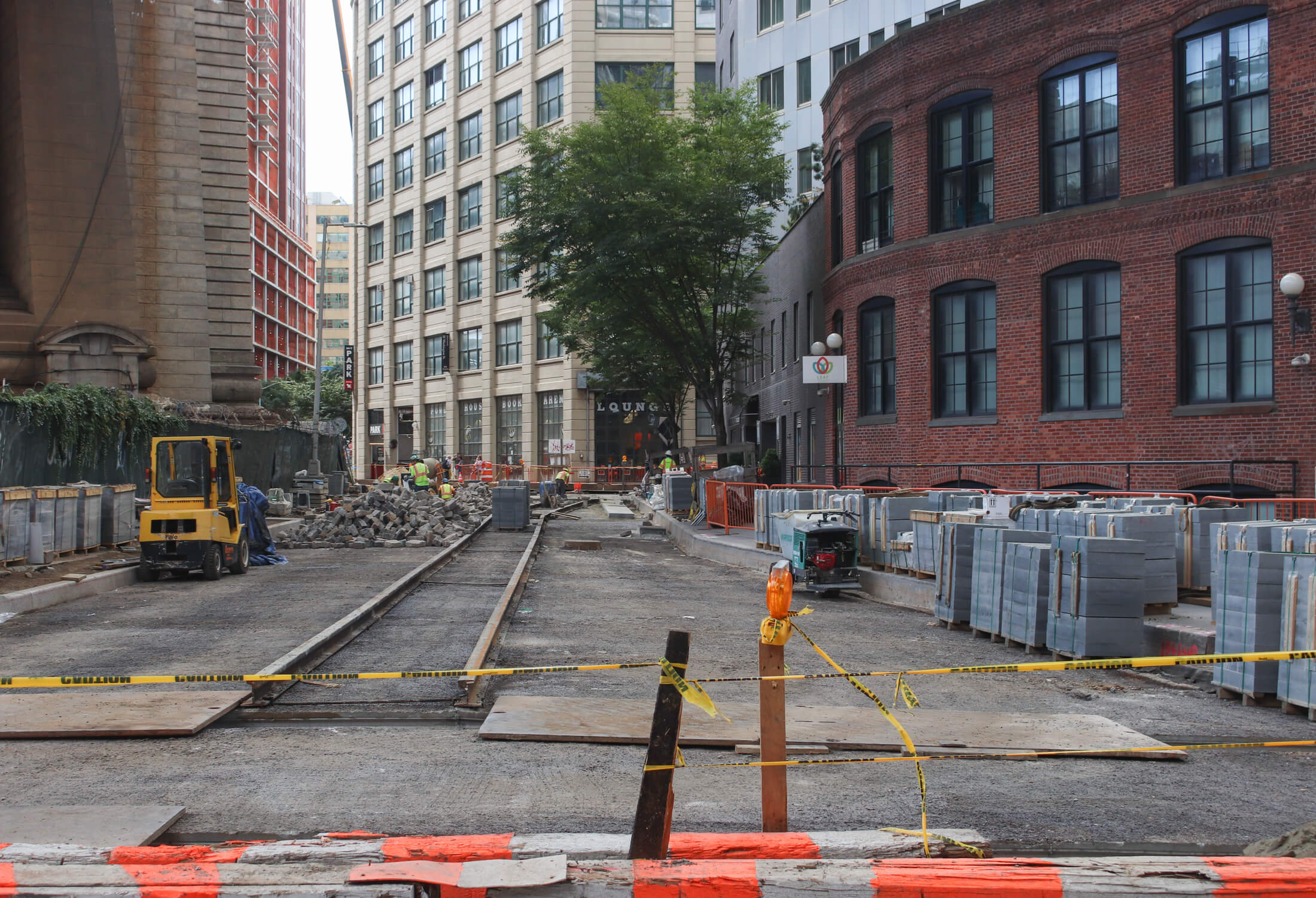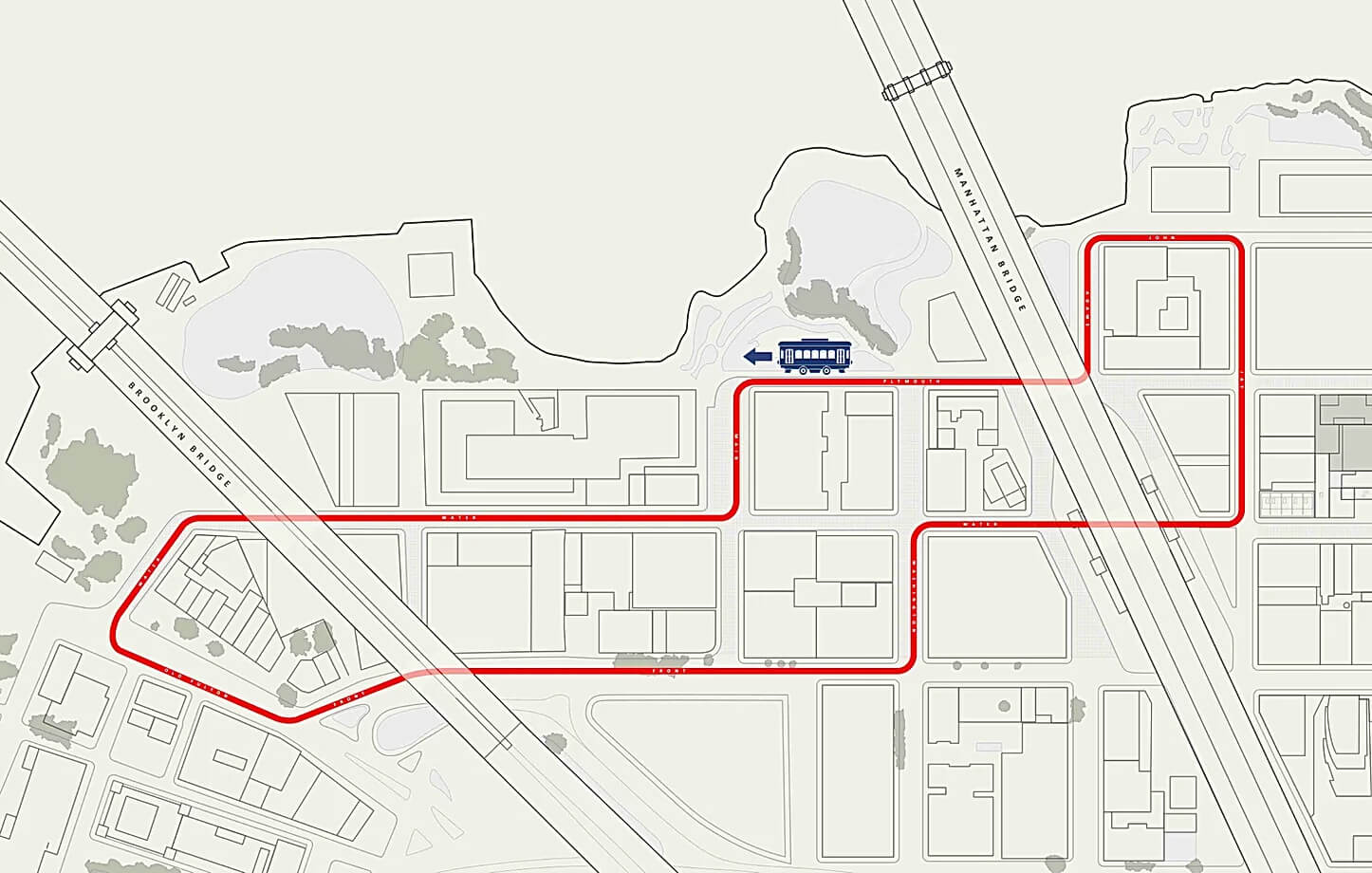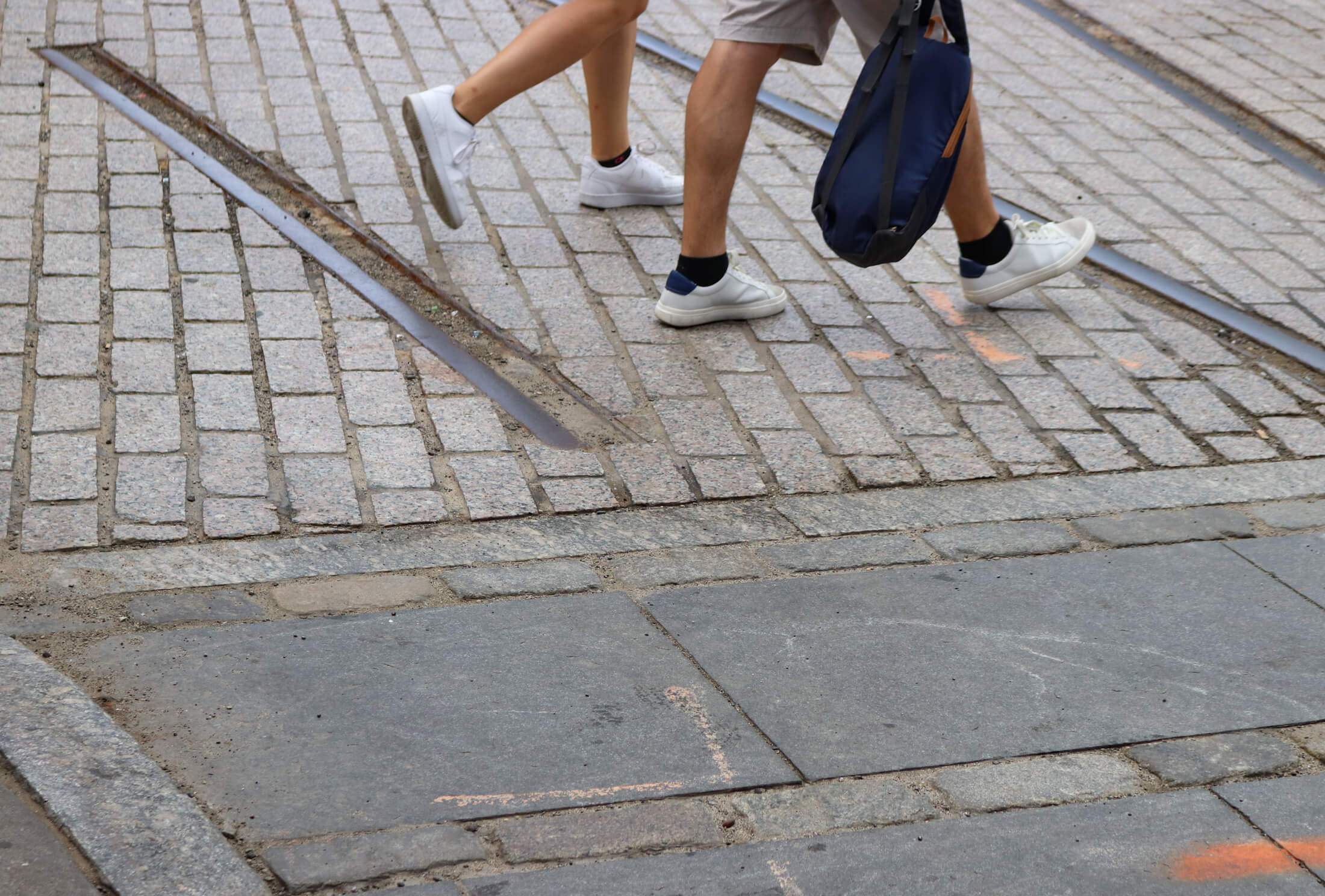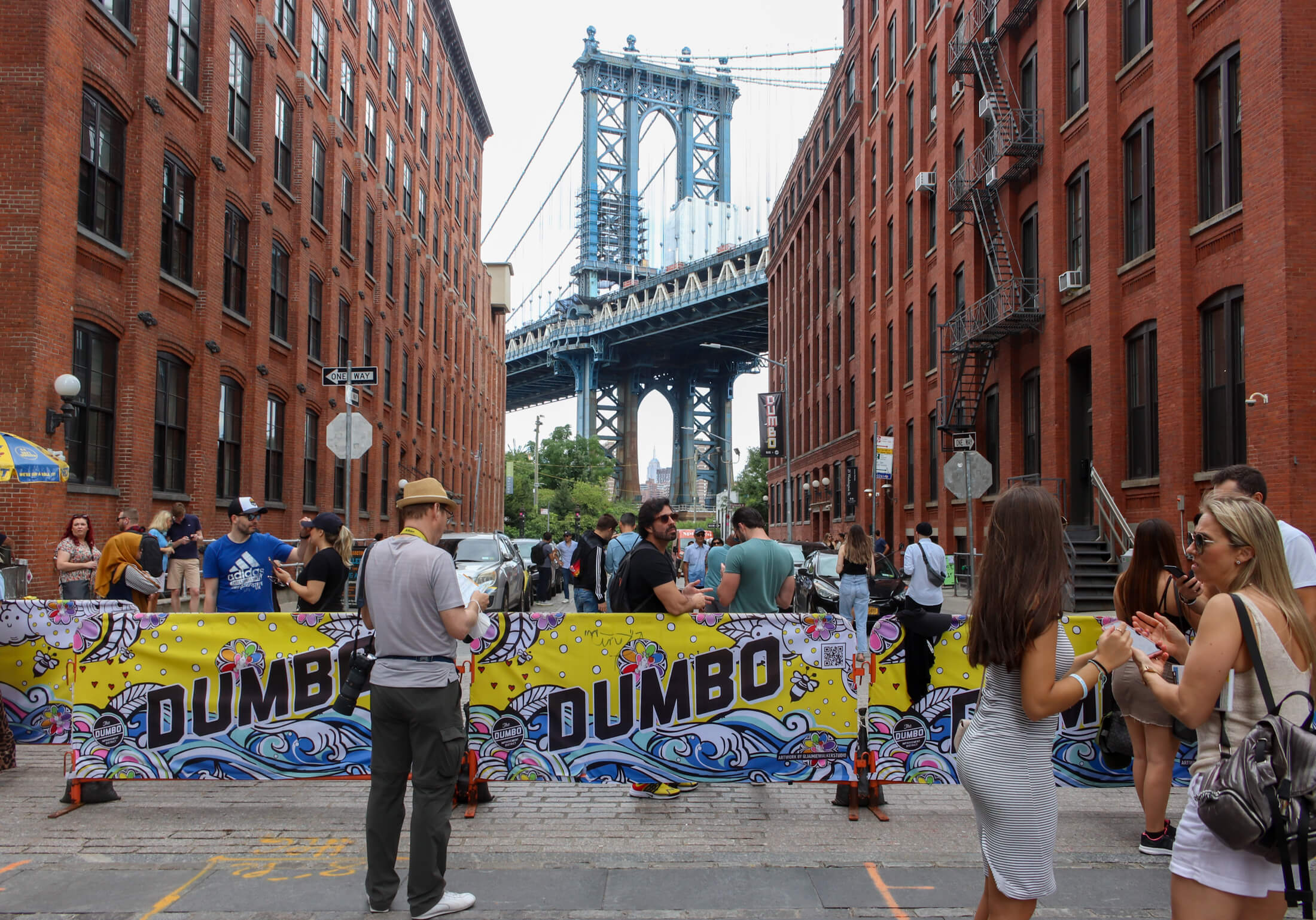New Group Wants to Bring Electric Commuter Trolleys to Historic Dumbo Rail Tracks
Friends of DUMBO Trolley Restoration wants the city to restore the neighborhood’s historic rail lines to functionality so they can be used by electric trolleys.

A view of embedded tracks along Plymouth Street. Photo by Susan De Vries
A new group has formed in Dumbo with the mission of bringing two electric-battery powered trolleys to the neighborhood’s historic train lines. Friends of DUMBO Trolley Restoration wants the tracks to be brought back to functionality, saying on its website an electric public transit option would improve air quality, transportation options and exposure for local businesses in the area.
The train tracks, visible along John, Jay, Plymouth, Adams, Main, Anchorage and other streets in the area, date from 1904 and were used by what was then known as the Jay Street Terminal Railway to transport goods from the docks to the warehouses and factories in the neighborhood. In 2007, they were landmarked by the Landmarks Preservation Commission as part of the Dumbo Historic District designation.
Now, as the Department of Transportation works with the Department of Design and Construction and DUMBO Improvement District to overhaul the streets in the area, former Jay Street resident and founder and director of brand promotion agency Household Name Adrian Saker says there is a major opportunity being missed.
“Not making the tracks functional ignores this important local history, and a joyful experience lost to future generations,” Saker told Brownstoner in a statement. “In the face of people wanting to go green, the problems of air and ground pollution, traffic congestion, and the city gaining population it is not unreasonable to think the trolley could make a return.”


Saker formed Friends of DUMBO Trolley Restoration a month ago with the goal of getting an electric battery-powered, silent, zero emission transit service with custom-built, ADA compliant trolleys to run through the neighborhood on the existing lines.
He says the group is not yet a formal entity and currently has no formal members, but has supporters in some longtime Dumbo residents and business owners. It is currently growing its following on social media and invites people to join. Saker said its supporters favor the clean transit vision and reducing local traffic congestion. There are no property developers involved or affiliations to real estate, he added.
Saker estimates each custom built trolley would cost between $1 and $1.5 million, and the vision is to have two trolleys running on the loop at 10 minute intervals. The replica trolleys envisioned would incorporate a percentage of refurbished vintage components such as trucks, motors, controllers and air brake systems, Saker said, plus climate control and WiFi. They would seat 24, with standing room for 22 others, and could reach a max speed of 30 miles per hour.
He said the group intends to apply for federal support, such as the 2015 Transportation Investment Generating Economic Recovery program, and other clean transit incentives to fund the project. He added the initiative would align with the current Capital Street Reconstruction Project being undertaken by the city.
“The 12-inch reinforced concrete pour on the ongoing road laying is sufficient to carry our dual-axle trolley weight and requires no additional railway ties,” he told Brownstoner. “This assessment comes from the site manager at the Adams Street reconstruction.”

The ‘DUMBO Loop’ proposed by Friends of DUMBO Trolley Restoration includes stops at the Brooklyn and Manhattan bridges, passes city parks and neighborhood landmarks, and would draw attention to local businesses, Saker said, while a free app would offer local discounts and rider amenities.
The proposal comes at a time when locals are pushing back against a deluge of tourists in the area, especially on Washington Street. Saker said to help alleviate this, the streetcar could help ferry a large portion of the visitors towards outlying businesses and “the many other tourist attractions they may not otherwise find.”
He said that wayfinding is limited in Dumbo and residents he had consulted supported the idea of an app offering certified residents free travel. He added the businesses he had spoken with unanimously support the idea of a trolley service.
Saker said there is a “trolley renaissance” under way across the country, and said it would be hard to find a more vibrant North American city that doesn’t have streetcars as part of its mass transit arsenal.
“Proposed congestion pricing will likely increase East River Ferry ridership and consequently parking gridlock in Dumbo. A local transit connection for ferry commuters and York Street Subway riders will help reduce this burden,” he added.
Neighborhood group DUMBO Neighborhood Alliance, which was instrumental in landmarking the area and attempting to save its historic Belgian blocks, expressed tentative interest in exploring “a new kind of transportation if it would support real restoration of streetscapes in our historic district,” said founding member Doreen Gallo. She was referring to the city’s controversial replacement of real historic cobblestones and rails in Dumbo with inauthentic new versions as part of its street revamp.
But this latest trolley project is “late to the game,” she added. Indeed, after a lengthy and contentious public process, the first phase of the street makeover is finished and the second phase is well under way. . “Early on there was a company promoting trolleys and the DUMBO Neighborhood Alliance was extremely supportive of their efforts,” Gallo said. But, “the city did not encourage their support at the time.”
“There’s a lot to explore regarding improved mobility in Dumbo and we are happy that people are thinking about creative and tech forward solutions,” said DUMBO Improvement District Executive Director Alexandria Sica, noting the busy area is “at the heart of Brooklyn’s economic recovery.”


A number of groups have proposed bringing trolleys back to Brooklyn, but none has made it past the pitching stage. The late trolley enthusiast and Atlantic Avenue tunnel tour guide Bob Diamond proposed a service from Red Hook to Downtown Brooklyn, and more recently Former Mayor Bill de Blasio backed the Brooklyn-Queens Connector (BQX), which was criticized for its cost and pandering to business and developer interests.
Unperturbed by these past failures, Friends of DUMBO Trolley Restoration intends to meet with Community Board 2 and LPC to propose expanding the Capital Street Reconstruction Project to include additional tracks for the ‘DUMBO Loop.’ Given the tracks are landmarked, the plans would need need to be OK’d by LPC.
Saker said when he canvassed locals for their thoughts, they saw trolleys as “charming and romantic” and suggested dressing them for July 4th, Pride, Halloween and Santa’s ride. He has also begun talking to museums about bringing a loaner trolley to Dumbo as a static showcase.
“While businesses are sensitive to delivery disruption, the Belgian cobblestones and tracks are being replaced at great expense, so let’s put a trolley on them,” Saker said.
[Photos by Susan De Vries unless noted otherwise]
Related Stories
- Walkabout: Brooklyn Trolley Dodgers, Part One
- Could Streetcars Return to Brooklyn?
- Dumbo’s Historic Belgian-Block Streets Will Not Survive Feds Unscathed: Report
Email tips@brownstoner.com with further comments, questions or tips. Follow Brownstoner on Twitter and Instagram, and like us on Facebook.









What's Your Take? Leave a Comment